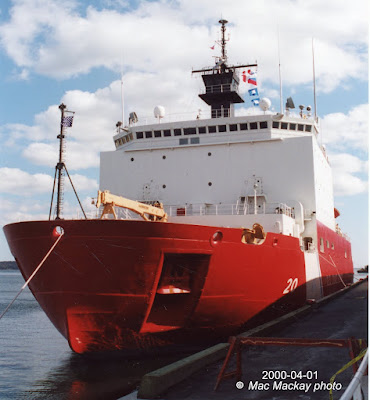
1. The dredge
Cranemaster lifts a bucket load of muck from the Narrows.
Work has started on the new seawall at pier 9 D. It is interesting that work has started this week, which marks the 94th anniversary of the Halifax Explosion, which was caused by the collision of two ships in the Narrows, a few hundred yards away.
The Halifax Port Authority has informed local residents that the work will be going on 24/7, and will involve dredging and construction of concrete cribs by slip forming.
It is all part of a $75 mn upgrade of the Richmond Terminals area, known as pier 9, 9A, 9B, 9C and 9D. Some of these pier faces date back 100 years according to the Port.
Once the home of a sugar refinery, a Dosco coal pier, a cement import terminal, the Volvo car assembly plant and Encana's supply base for offshore exploration, Richmond Terminals has been underutilized in recent years. The drilling mud storage tanks operated by MI-Swaco are still operational, and there is activity in several of the sheds, including Marener Industries' boat building operation and International Telecom.
Work to reinforce the faces of the existing concrete piers was completed this fall. The structure was being undermined, and it was a major job to pin the faces back and drive new sheet piles and build new cope walls. Work is also well advanced on rebuilding the internal roadway system within the terminal area. There have also been improvements to the sheds.
The Pier 9C extension (as the Port calls it) is really the installation of whole new pier face to the Pier 9D area, which up until now has just been fill. The work will allow ships to tie up there for break bulk and RoRo cargo, and the Port hopes to attract processing, transloading and distribution operations for export.
One would be free to wonder why, with low utilization of the deep water terminals, this work is needed. It seems to me that there are other plans for the deepwater terminals, and we just haven't heard what they might be - yet.
Use of this area would also remove truck activity from downtown streets - a real plus when it comes to large items such as windmill blades (but that is import work) or utility poles (for export.)
Today's activity involves the dredge Cranemaster, tug Swellmaster and mud scow HD8, operated by Harbour Development Ltd. They are forming a level base and removing loose material, so that a gravel mat can be installed. The new cribs will sit on that base to form the new cope wall. Filling behind the new wall will proceed once the area is tight.
It will be interesting to watch the progress of this work in the Narrows.
.




















